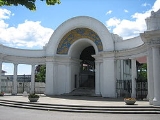
Sunnyside Bathing Pavilion
Encyclopedia
Sunnyside Bathing Pavilion is a landmark public pavilion in the Sunnyside lakefront area of Toronto
, Ontario
, Canada
. Built in 1922, its original function was to provide changing facilities for swimming in Lake Ontario
, however lake conditions were often too cold and an adjoining public swimming pool was built in 1925. The Pavilion was renovated in 1980 to provide updated changing facilities and a café along the beach and a garden.
had been popular for over thirty years, as there was a swimming area near a pumping station. This changed in 1913 when the pumping station was demolished to make way for the bridge connecting Lakeshore Road and the King/Queen/Roncesvalles intersection. A staircase was built for pedestrians to walk down to the shoreline. A slide was installed for bathers to slide down into the water. By 1920, this area was filled in and the beach was moved farther to the south.
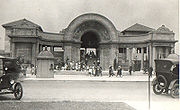 On June 28, 1922, Toronto Mayor Charles A. Maguire
On June 28, 1922, Toronto Mayor Charles A. Maguire
opened the Sunnyside Bathing Pavilion to help bathers change for the swim in the lake. The building, constructed of concrete, cost $300,000. Each wing held an outdoor changing area, lockers and showers, the women's side on the east, and men's side on the west. It offered over 7700 lockers for patrons, a roof garden for 400. Admission fees were 25¢ for adults and 15¢ for children, and bathing suits and towels could be rented. In the center was a staircase leading to an upper terrace which overlooked the change areas leading to a rear terrace which ran the full length of the building and overlooked the beach.
The building was designed by Alfred Chapman
who had designed the Princes' Gates and the Ontario Government Building at Exhibition Place
for the Canadian National Exhibition
(CNE). The bathing pavilion design was based on the bathing pavilion at Lynn Beach in Massachusetts
.
The Pavilion was the site of the first 'Miss Toronto' beauty pageant in 1926.
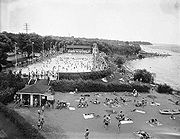
The 'Tank' was especially popular with children as special streetcar runs were made to take children to the Pool directly from around the City. When built, the pool had a diving tower and bleachers on the east end. The tower was replaced with a simple diving board before 1980, and the diving board itself was eventually removed.
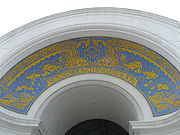
's coach, the founder and coach of the Lakeshore Swim Club of New Toronto.
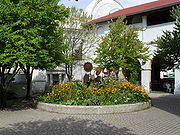
Toronto
Toronto is the provincial capital of Ontario and the largest city in Canada. It is located in Southern Ontario on the northwestern shore of Lake Ontario. A relatively modern city, Toronto's history dates back to the late-18th century, when its land was first purchased by the British monarchy from...
, Ontario
Ontario
Ontario is a province of Canada, located in east-central Canada. It is Canada's most populous province and second largest in total area. It is home to the nation's most populous city, Toronto, and the nation's capital, Ottawa....
, Canada
Canada
Canada is a North American country consisting of ten provinces and three territories. Located in the northern part of the continent, it extends from the Atlantic Ocean in the east to the Pacific Ocean in the west, and northward into the Arctic Ocean...
. Built in 1922, its original function was to provide changing facilities for swimming in Lake Ontario
Lake Ontario
Lake Ontario is one of the five Great Lakes of North America. It is bounded on the north and southwest by the Canadian province of Ontario, and on the south by the American state of New York. Ontario, Canada's most populous province, was named for the lake. In the Wyandot language, ontarío means...
, however lake conditions were often too cold and an adjoining public swimming pool was built in 1925. The Pavilion was renovated in 1980 to provide updated changing facilities and a café along the beach and a garden.

History
By the 1920s, swimming at the foot of Roncesvalles AvenueRoncesvalles Avenue
Roncesvalles Avenue is a north-south arterial street in Toronto, Canada. It connects Queen Street West, King Street West and runs north to Dundas Street West. Roncesvalles Avenue takes its name from the Battle of Roncesvalles, which took place in the Roncesvalles gorge in Spain in 1813...
had been popular for over thirty years, as there was a swimming area near a pumping station. This changed in 1913 when the pumping station was demolished to make way for the bridge connecting Lakeshore Road and the King/Queen/Roncesvalles intersection. A staircase was built for pedestrians to walk down to the shoreline. A slide was installed for bathers to slide down into the water. By 1920, this area was filled in and the beach was moved farther to the south.

Charles A. Maguire
Charles Alfred Maguire was mayor of Toronto from 1922-1923.Charles Alfred Maguire was born in Toronto, the son of James Maguire and Elizabeth Brown....
opened the Sunnyside Bathing Pavilion to help bathers change for the swim in the lake. The building, constructed of concrete, cost $300,000. Each wing held an outdoor changing area, lockers and showers, the women's side on the east, and men's side on the west. It offered over 7700 lockers for patrons, a roof garden for 400. Admission fees were 25¢ for adults and 15¢ for children, and bathing suits and towels could be rented. In the center was a staircase leading to an upper terrace which overlooked the change areas leading to a rear terrace which ran the full length of the building and overlooked the beach.
The building was designed by Alfred Chapman
Chapman and Oxley
Chapman and Oxley was a Toronto, Ontario, Canada - based architectural firm and responsible for designing a number of Beaux Arts buildings in the city in the 1920s and 1930s...
who had designed the Princes' Gates and the Ontario Government Building at Exhibition Place
Exhibition Place
Exhibition Place is a mixed-use district in Toronto, Ontario, Canada, by the shoreline of Lake Ontario, just west of downtown. The 197–acre area includes expo, trade, and banquet centres, theatre and music buildings, monuments, parkland, sports facilities, and a number of civic, provincial,...
for the Canadian National Exhibition
Canadian National Exhibition
Canadian National Exhibition , also known as The Ex, is an annual event that takes place at Exhibition Place in Toronto, Ontario, Canada during the 18 days leading up to and including Labour Day Monday. With an attendance of approximately 1.3 million visitors each season, it is Canada’s largest...
(CNE). The bathing pavilion design was based on the bathing pavilion at Lynn Beach in Massachusetts
Massachusetts
The Commonwealth of Massachusetts is a state in the New England region of the northeastern United States of America. It is bordered by Rhode Island and Connecticut to the south, New York to the west, and Vermont and New Hampshire to the north; at its east lies the Atlantic Ocean. As of the 2010...
.
The Pavilion was the site of the first 'Miss Toronto' beauty pageant in 1926.

The 'Tank'
On July 29, 1925, due to coldness of the lake during the preceding two summers, the Sunnyside Pool, nicknamed the 'Tank', was opened beside the Bathing Pavilion to the east. It measured 300 feet (91.4 m) by 75 feet (22.9 m) and could accommodate 2,000 swimmers. At the time of construction, the pool was considered the largest outdoor swimming pool in the world. Admission fees were 35¢ for adults, 10¢ for children.The 'Tank' was especially popular with children as special streetcar runs were made to take children to the Pool directly from around the City. When built, the pool had a diving tower and bleachers on the east end. The tower was replaced with a simple diving board before 1980, and the diving board itself was eventually removed.

Renovated facility
The Sunnyside Bathing Pavilion was renovated in 1980. The outdoor lockers and changing areas were demolished and new changing rooms were built. The pool was rededicated as the 'Gus Ryder Pool', named after Marilyn BellMarilyn Bell
Marilyn Bell Di Lascio is a retired long distance swimmer, born October 19, 1937, in Toronto, Ontario. She was the first person to swim across Lake Ontario and later swam the English Channel and Strait of Juan de Fuca.-Swimming career:...
's coach, the founder and coach of the Lakeshore Swim Club of New Toronto.
East wing
The east wing of the pavilion, which formerly held the outdoor women's changing area became a new enclosed changing facility with new men's and women's changing areas. The former entrance from the archway area was closed and a new entrance was cut in the north wall to enter the changing area.

